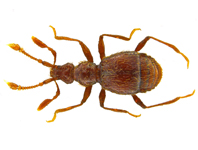Abstract
In this article we report on a hexactinellid sponge new to science, Rhizophyta yapensis gen. et sp. nov., which was collected from the Yap Trench in the northwestern Pacific Ocean at an abyssal depth of 4159–4779 m. Its fungus-like body form with long peduncle and absence of hypodermalia suggest placement within the euplectellid subfamily Bolosominae Tabachnick, 2002, whereas molecular phylogenetic evidence suggests that it is sister to all remaining Euplectellidae Gray, 1867. Its rhizophytous method of attachment to the substrate, hitherto unknown from bolosomine Euplectellidae, a veil of pentactins covering the peduncle, and the presence of toothed discohexasters as the only type of microscleres, clearly characterize it as a new genus. The intraspecific divergence between holotype and paratypes of the new species is examined with both morphological and molecular approaches. This report represents the first record of a hexactinellid sponge from the Yap Trench.
References
Belyaev, G.M. (1989) Deep-sea Ocean Trenches and Their Fauna. Moscow: Nauka.
Bergsten, J. (2005) A review of long-branch attraction. Cladistics, 21, 163–193.
https://doi.org/10.1111/j.1096-0031.2005.00059.x
Dohrmann, M. (2019) Progress in glass sponge phylogenetics: a comment on Kersken et al. (2018). Hydrobiologia [in press]
https://doi.org/10.1007/s10750-018-3708-7
Dohrmann, M., Janussen, D., Reitner, J., Collins, A.G. & Wörheide, G. (2008) Phylogeny and evolution of glass sponges (Porifera, Hexactinellida). Systematic Biology, 57, 388–405.
https://doi.org/10.1080/10635150802161088
Dohrmann, M., Kelley, C., Kelly, M., Pisera, A., Hooper, J.N.A. & Reiswig, H.M. (2017) An integrative systematic framework helps to reconstruct skeletal evolution of glass sponges (Porifera, Hexactinellida). Frontiers in Zoology, 14, 18.
https://doi.org/10.1186/s12983-017-0191-3
Downey, R.V. & Janussen, D. (2015) New insights into the abyssal sponge fauna of the Kurile–Kamchatka plain and Trench region (Northwest Pacific). Deep-Sea Research Part II, 111, 34–43.
https://doi.org/10.1016/j.dsr2.2014.08.010
Folmer, O., Black, M., Hoeh, W., Lutz, R. & Vrijenhoek, R. (1994) DNA primers for amplification of mitochondrial cytochrome c oxidase subunit I from diverse metazoan invertebrates. Molecular Marine Biology and Biotechnology, 3, 294–299.
Fujiwara, T., Tamura, C., Nishizawa, A., Fujioka, K., Kobayashi, K. & Iwabuchi, Y. (2000) Morphology and tectonics of the Yap Trench. Marine Geophysical Researches, 21, 69–86.
https://doi.org/10.1023/A:1004781927661
Gong, L. (2016) The taxonomy of deep sea sponges from the West Pacific Ocean and preliminary study of their molecular phylogeny. Institute of Oceanology, Chinese Academy of Sciences, Qingdao, 178 pp.
Jamieson, A. (2015) The hadal zone: life in the deepest oceans. Cambridge University Press, Cambridge, 372 pp.
Lemche, H., Hansen, B., Madsen, F.J., Tendal, O.S. & Wolff, T. (1976) Hadal life as analysed from photographs. Videnskabelige Meddelelser Fra Dansk Naturhistorik Forening, 139, 263–336.
Pattengale, N.D., Alipour, M., Bininda-Emonds, O.R.P., Moret, B.M.E. & Stamatakis, A. (2010) How many bootstrap replicates are necessary? Journal of Computational Biology, 17, 337–354.
https://doi.org/10.1007/978-3-642-02008-7_13
Reiswig, H.M. & Kelly, M. (2018) The marine fauna of New Zealand. Euplectellid glass sponges (Hexactinellida, Lyssacinosida, Euplectellidae). NIWA Biodiversity Memoirs. 130, 1–170.
Stamatakis, A. (2014) RAxML version 8: a tool for phylogenetic analysis and post-analysis of large phylogenies. Bioinformatics, 30, 1312–1313.
https://doi.org/10.1093/bioinformatics/btu033
Stamatakis, A., Hoover, P. & Rougemont, J. (2008) A rapid bootstrap algorithm for the RAxML web servers. Systematic Biology, 57, 758–771.
https://doi.org/10.1080/10635150802429642
Tabachnick, K.R. & Lévi, C. (2004) Lyssacinosida du Pacifique sud-ouest (Porifera: Hexactinellida). In: Marshall, B.A. & Richer de Forges, B. (Eds.), Tropical Deep-Sea Benthos 23. Mémoires du Muséum national d'Histoire naturelle. 191, 11–71.
Tabachnick, K.R. (2002) Family Euplectellidae Gray, 1867. In: Hooper, J.N.A. & Van Soest, R.W.M. (Eds.), Systema Porifera: A Guide to the Classification of Sponges. Kluwer Academic/Plenum Publishers, New York, pp. 1388–1434.
https://doi.org/10.1007/978-1-4615-0747-5_146

